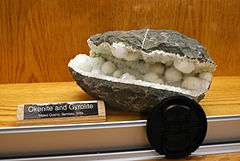Gyrolite
| Gyrolite | |
|---|---|
|
Gyrolite | |
| General | |
| Category | Phyllosilicate |
| Formula (repeating unit) | NaCa16Si23AlO6(OH)8·14H2O |
| Strunz classification | 9.EE.30 |
| Dana classification | 73.2.2c.1 |
| Crystal system | Triclinic |
| Crystal class |
Pinacoidal (1) H-M symbol: (1) |
| Space group | P1 |
| Unit cell |
a = 9.74, b = 9.74 c = 22.4 [Å]; α = 95.71° β = 91.51°, γ = 120.01°; Z = 4 |
| Identification | |
| Color | White, colorless, green, yellow or brown |
| Crystal habit | Compact, lamellar, platy |
| Twinning | Lamellar |
| Cleavage | Perfect on {001} |
| Tenacity | Brittle |
| Mohs scale hardness | 2½ |
| Luster | Vitreous, pearly |
| Diaphaneity | Transparent, translucent, opaque |
| Density | 2.45 - 2.51 |
| Optical properties | Biaxial (-) |
| Refractive index | nα = 1.535 nβ = 1.548 nγ = 1.549 |
| Birefringence | δ = 0.0140 |
| References | [1][2][3] |
Gyrolite (NaCa16Si23AlO6(OH)8·14H2O)[2] is a silicate mineral that is usually associated with zeolites. It most commonly is found as spherical or radial formations in hydrothermally altered basalt and basaltic tuffs.[2] These formations can be glassy, dull or fibrous in appearance.[4]
Gyrolite is also known as Centrallasite, Glimmer Zeolite or Gurolite.[2]
Discovery and occurrence
It was first described in 1851 for an occurrence at The Storr on the isle of Skye, Scotland and is named from the Greek word for circle, guros, based on the round form in which it is commonly found.[3]
Minerals associated with gyrolite include apophyllite, okenite and many of the mother zeolites.[4] Gyrolite is found in Scotland, Ireland; Italy, Faroe Islands, Greenland, India, Japan, USA, Canada and various other localities.[1][2]
References
- 1 2 Gyrolite in the Handbook of Mineralogy
- 1 2 3 4 5 "Gyrolite".
- 1 2 Dave Barthelmy. "Gyrolite Mineral Data".
- 1 2 "GYROLITE (Hydrated Calcium Silicate Hydroxide)". Galleries.com. Retrieved 2016-02-27.
| Wikimedia Commons has media related to Gyrolite. |
